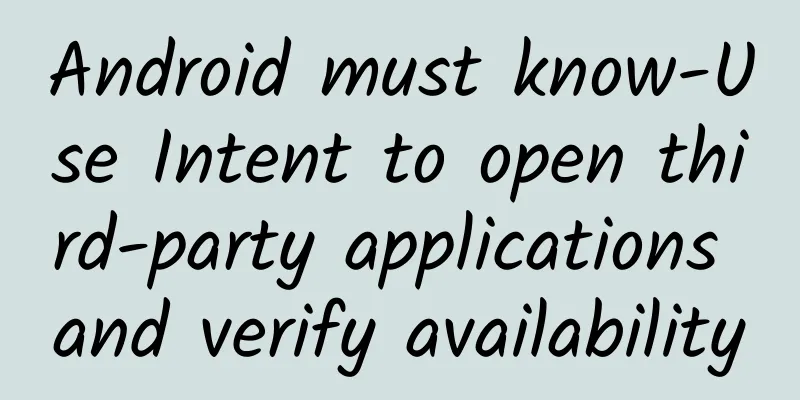Android must know-Use Intent to open third-party applications and verify availability

|
This article mainly records:
Basics 1. App entry Activity and its icon
A normal application will have an entry Activity by default, which is usually written in AndroidManifest.xml as follows:
Only when such an Activity is configured, the application will know which Activity to start when it is clicked. If the value of category is changed to android.intent.category.DEFAULT, then the icon of this application will not be visible on the desktop and it cannot be opened directly. How to use Intent to open a third-party application or specify an Activity
1. Use PackageManager.getLaunchIntentForPackage()
This method is used when you only know the package name and want to start the application. The biggest restriction on the application is that there is a default entry Activity. When there is no default entry Activity, a NullPointerException will be reported:
Let’s take a look at the description of the getLaunchIntentForPackage() method:
public abstract Intent getLaunchIntentForPackage(String packageName); So you can use this method to determine whether the Intent is empty.
2. Use Intent.setComponent()
This method can start an application-specified Activity, not limited to the default entry Activity. However, this method requires many conditions, as follows: Know the package name of the App and the full path and name of the Activity
The following is a very common usage circulating on the Internet:
Unfortunately, the Intent.resolveActivity() method cannot determine whether the Activity to be started in this way exists. If this Activity does not exist, a java.lang.IllegalArgumentException: Unknown component exception will be reported, causing the program to crash. Let's look at the code for resolveActivity() and its similar method resolveActivityInfo():
Obviously, in this method, we set the ComponentName first, so mComponent will be returned directly to us without any judgment logic. In contrast, resolveActivityInfo() can make effective judgments and return null. Therefore, we choose to use Intent.resolveActivityInfo() to make judgments in this way:
3. Implicitly launch third-party applications This method is mostly used to start functional applications in the system, such as making calls, sending emails, previewing pictures, opening a web page using the default browser, etc.
There are many implicit startup functions, so I won’t list them all. You can directly search for relevant codes when needed. Let’s take opening a web page as an example:
At this point, there is nothing wrong with using the Intent.resolveActivity() method directly:
Summarize After reading the PackageManager code, I found that you can also use the packageManager.queryIntentActivities() method to determine whether there is an application in the system that can parse the specified Intent.
So, to sum up:
|
>>: Teach you step by step to publish your own CocoaPods open source library
Recommend
What caused the mysterious "strange disease" that appeared in Japan in the 1950s?
In the 1950s, the villagers of Minamata Village i...
Why would a spider magnified 100 times be crushed by itself?
Today we are going to talk about a topic that is ...
Don’t worry about AI eating up your job. It may be the software itself that’s eating up your job.
summary There is a great deal of hype about recen...
Why is information flow so popular nowadays? What kind of advertising will dominate the future?
Explore the past, present and future of Internet ...
Zhang Ce: The Making of a Short Video Director, Short Video Creation Course
It’s simple and easy to understand, and you can t...
It is said online that "China's high-speed rail consumes 10,000 kilowatt-hours of electricity per kilometer". Is this true?
Nowadays, high-speed rail has brought great conve...
In-depth analysis of Douyin e-commerce algorithm
Douyin e-commerce is like a game, and the algorit...
How should Tik Tok create a hit? Official TikTok hit tips!
The rise of short videos has brought countless ne...
The development of VR industry faces technical and content difficulties, but future development is promising
VR uses computer simulation to create a three-dim...
Wang Fang: Beautiful Greater China
: : : : : : : : : : : : : : : .mp3 8.63M ├──【Free ...
Can WeChat Mini Programs upload multiple Mini Programs to one account?
Q: Can a WeChat Mini Program upload multiple Mini...
How to buy the Kuaishou popularity agreement, or where to buy popularity?
Professional Douyin and Kuaishou likes-boosting p...
Caixuetang's "Stock Market Trend Trading Method 1+2+3" deciphers the main trading techniques and gives you the supreme strategy system
Caixuetang's "Stock Market Trend Trading...
SAIC-GM-Wuling: SAIC-GM-Wuling's sales in Q1 2025 exceeded 377,000 units, and the new energy sector surged by 121.9%
According to recent news, SAIC-GM-Wuling's sa...
Kang Ge: Build a small money-making machine in 30 days
Kang Ge's resource introduction of "Build...









